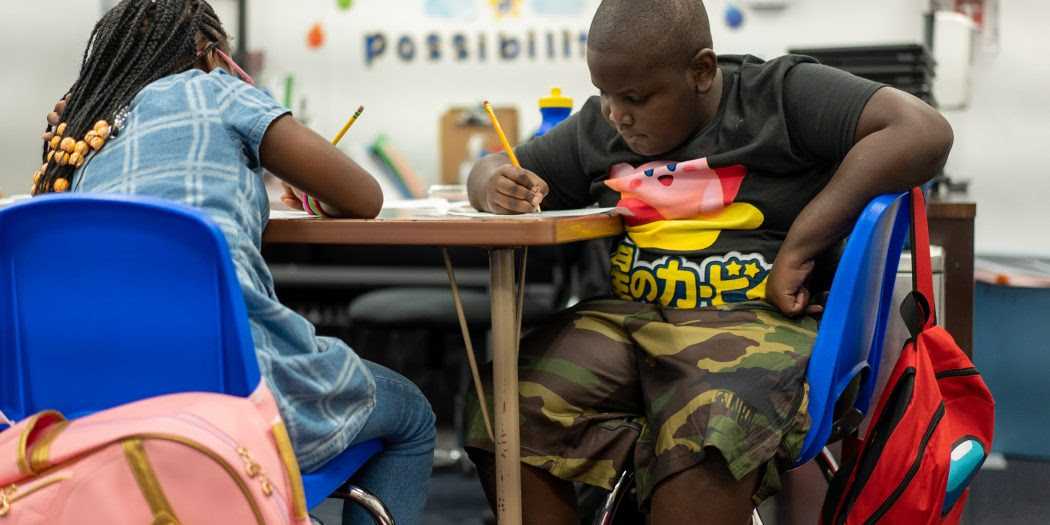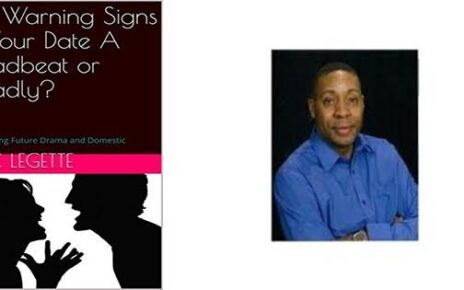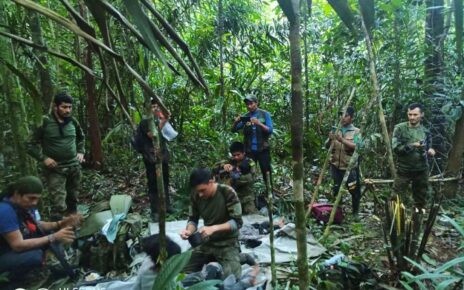Caring and Sharing Learning School Bridging The Achievement Gap in Gainesville Florida
Alachua County has the widest achievement gap between Black and white students in the state. Caring and Sharing Learning School’s students, nearly all Black, earned the highest learning gains in the district this year, outperforming the county’s white students on the state assessment.
The dropoff loop at Caring and Sharing Learning School buzzes with excitement. Children throw up backward peace signs and Spiderman hands for mothers snapping pictures. “Colorform” dress code requires blue and white clothing, so individuality spills out at their extremities: in Air Jordans and “Black Girl Magic” backpacks, in designs cut into fresh fades and beads clinking at the ends of newly twisted braids. It’s the first day of school.
Principal Curtis Peterson points a student to their classroom on the first day at Caring and Sharing Learning School. Peterson said the school’s biggest challenge is what he calls a “PR problem” – people see Black students in an under-resourced area of town and underestimate them. (Katie Hyson/WUFT News)
It’s this image – Black and brown students across the street from Gainesville Housing Authority on the east side of town – that staff and parents said causes wrong assumptions that it’s an alternative school for children public schools can’t handle or teach.
Their assumptions, stakeholders said, blind them to what they’re really looking at: An A-rated school with the highest learning gains in the district; a school whose students regularly feed into magnet programs and earn college degrees, and who outperformed the county’s white students on the state assessment; a 2017 National Blue Ribbon School and a 2010 Title I Distinguished School.
It’s a school helping to close Alachua County’s achievement gap between Black and white students – at 45 percentage points in both math and English, it’s the widest in the state.
There are 277 students currently enrolled, and waiting lists for multiple grades. More than 98% are minorities, mostly Black. Children of lawyers, doctors and public figures mingle with children from the government housing across the street.
Staff said even parents from high-earning professions can have burdensome demands on their incomes. Last school year, 100% of their students met the district’s definition of “economically disadvantaged.”
The children grab free boxes of Lucky Charms and chocolate milks and largely bypass the bin of oranges before funneling into classrooms. At the doorways, teachers welcome them back by name.
The third graders in Jeanee Williams’ class sit down to a hip hop video exemplifying the various types of nouns – “a car, a fish, Beyoncé, a wish.”
Williams asks them to stand for morning affirmations.
Together, they speak words to arm them in the battle against the county’s mountainous achievement gap, and the towering assumptions placed on Black children in America.
“When faced with a mountain, I will not quit!” dozens of small voices say.
“I will keep on striving until I climb over, find a path through, tunnel underneath, or simply stay and turn that mountain into a gold mine.
“I will do my best.
“I know I can.
“I am a winner.
“I am somebody.”
“I know I can,” students recite in Jeanee William’s third grade classroom. Williams said not “buying in” to low expectations of Black students is the first step in their success. They start every day with affirmations. (Katie Hyson/WUFT News)
Burying ‘I can’t’
The school’s cofounders, Simon and Verna Johnson, know what it is to be underestimated.
Verna Johnson was born in Jasper, Florida, in 1940.
There were no lights or running water in her home, she said. The bathrooms were outside. Though no one in her sprawling family had yet finished high school, she was determined to use education as a way out of the fields she toiled in: tobacco, cotton and cucumber. (To this day, she will not touch a sandwich with pickles on it.)
Verna Johnson was the first member of her family to finish high school and earn a college degree. She founded Caring and Sharing Learning School with her husband to prove that any child can learn. (Katie Hyson/WUFT News)
She graduated from Edward Waters College in 1964 and began a teaching career, eventually taking a position at A.L. Mebane in Alachua County.
When the school district began receiving pressure to desegregate, Verna Johnson was asked to interview with all-white schools that “had to prove to the state” they had “a Black, or colored – whatever they were calling us at that time.”
During one interview at Littlewood Elementary, she remembers the then-principal asking her: “How did you learn to talk?”
Verna Johnson wanted to continue serving the children at Mebane. She declined requests to teach at white schools despite what she said was a risk of never working in the county again – until the federal desegregation mandate.
In December 1969, students in Alachua County went home for winter break. While the children were away, the county closed the Black schools. Verna Johnson was sent to Glen Springs Elementary in northwest Gainesville.
When the kindergarteners at Glen Springs wanted to rub her skin, she let them. She taught them a new, “big word.”
Melanin.
When they wanted to touch her hair, she let them. She put their hairs and one of her own under a microscope, and taught them the difference between curly and straight.
She was the first Black person to move into the area near the school, she said. She received calls from her hometown that people were coming there to investigate her past.
She described some white parents being shocked to learn that the teacher their child raved about, and was learning so much from, was Black.
Simon Johnson was surprised, too, she said.
When they retired, Simon and Verna Johnson founded Caring and Sharing Learning School. Verna Johnson said they didn’t take paychecks for a while, and put their own money into the school. (Katie Hyson/WUFT News)
She knew of him already – he was the first Black tenured professor in the University of Florida’s College of Education. When he came to her classroom to meet the teacher he’d heard so many excellent things about, she said, he went to shake the hand of the white aid instead, who was standing behind Verna Johnson’s desk.
She laughs recounting the bumpy start to what would become a still ongoing four-decades-long marriage.
Together, they authored books and traveled teaching workshops on classroom strategies.
For decades, Verna Johnson told people any child could learn. When the charter school movement began in the ‘90s, she wanted to prove it.
Instead of resting when they retired, the Johnsons founded Caring and Sharing Learning School.
It wasn’t the money grab some assume of charter schools, Verna Johnson said. For a time, they didn’t take salaries. When the $50,000 starting fund wasn’t enough, they sunk their own money into it.
After the school opened in 1998, Verna Johnson took her new students outside. They dug a hole into the school ground.
Together, they held a funeral for “Mr. and Mrs. I Can’t,” and buried the words for good.
When asked why she founded Caring and Sharing Learning School instead of resting in retirement, Verna Johnson paraphrased an old gospel hymn: “If I could help someone along this way, then my life would not have been in vain.” (Katie Hyson/WUFT News)
‘This is Wakanda, baby boy!’
Curtis Peterson, Verna Johnson’s son, took over as principal in 2008. He said almost everyone who works at the school has a similar chip on their shoulder.
Principal Curtis Peterson said many who work at the school have been underestimated. He was once mistaken for a custodian, he said, when he arrived to teach in a wealthy school district in Sarasota. (Katie Hyson/WUFT News)
Being underestimated and overlooked has given them a drive to prove the world wrong – about themselves and the students they see themselves in.
In class, Jeanee Williams is telling her third graders an abbreviated version of her background, how she grew up in the projects of “Liberty City” in Miami, “the Pork ‘n’ Beans.”
“I got the drive from my dad, and the love of learning from my mom,” she tells them.
Jeanee Williams, who grew up in the projects of Miami, said she sees herself in her students. (Katie Hyson/WUFT News)
Some details are not on her PowerPoint slide: How her father, who had dyslexia and dropped out of school, drilled it into her “that education is power, knowledge is the key”; how her teen mother read to her in the womb.
She worked daycare for a homeless shelter during high school and earned an associate’s degree at the same time – one of the only African American students in the dual enrollment program, she said.
When she told her guidance counselor she was considering the University of Florida, she said, the counselor cautioned her to consider other options because she might not get in.
It bothered her. When she later received a full ride, she made sure to write UF in very large letters on her high school’s board of college acceptances.
“It put a fire under me,” she said. “You say I can’t do it. I’m gonna make you eat your words.”
She graduated with her master’s degree in 2011.
When the children look at the teachers and staff of Caring and Sharing, most of whom are Black, they can see themselves reflected in people who have accomplished something.
Principal Curtis Peterson looks in the doorway of a third grade classroom, in which Assistant Principal Kareem Epps is working. Peterson stressed the importance of students being able to see themselves in school leadership, especially Black males. (Katie Hyson/WUFT News)
Peterson said there’s no excuse for the underrepresentation of Black teachers and administration in the district.
He and members of his staff called false the justification that Black candidates, especially Black males, just can’t be found. Peterson said he actively recruits from historically Black colleges and universities.
“They’re available and willing, if invited to the table,” said Mavis Muhammad, Verna Johnson’s daughter and the school’s Title I lead teacher and instructional coach.
In a state where legislators recently passed restrictions on discussions of race in the classroom, reminders of the students’ value and possibility cover the walls: fine art of Black children in the hallways and bathrooms; a portrait of the Obamas at the front door; Black Panther superhero decorations on classroom walls.
“This is Wakanda, baby boy!” Peterson tells one student with a fist bump.
Staff teach students Black history not just in February, but every day.
They show them that they can make a difference, because they come from a lineage of people who have made a difference.
With Civil Rights lessons, they prepare the students for the day they will leave for other schools and become a minority.
Students color introduction sheets for their first day of math class. Last school year, every Caring and Sharing Learning School student in the lowest performing quartile for math made learning gains. (Katie Hyson/WUFT News)
‘The invisible backpack’
At the back table of Williams’ classroom, a third grader’s eyebrows knit together in anguish. It’s lunchtime.
“Why did my mom not get me a freaking spoon?” he cries. “This is the freaking worst day I’ve ever lived!”
“Can you try to stop saying ‘freaking’ so much?” another third grader asks.
The entrance of Principal Peterson cuts short a heated table-wide debate over what is and is not a “bad word.”
Peterson calls to a child whose eyes are narrowed in what looks like a perpetual frown.
“I’m tired of you squinting,” Peterson says. “Do you have your glasses in that backpack?”
“No, sir.”
“Are you sure?”
“No, sir.”
“You know I’m going to call home and check. You can’t see, you can’t learn.”
“Only if you have magic powers that can make them be in my backpack somehow.”
“Making sure you weren’t just hiding them because you don’t want to wear them,” Peterson says. “Smartest people in the world wear glasses. Look at me!”
While Peterson turns on old Jackson 5ive cartoons, the child turns back to his lunch.
Under his breath, he adds: “But Ms. Williams never wears glasses, and she’s smart.”
The school’s approach is driven by the idea that every child carries “an invisible backpack.”
They may not have had food that morning, Verna Johnson explained, or a place to stay the night before. They might not have slept because their parents were fighting, or one or both parents might be in jail. You just don’t know.
But all some teachers see, she said, is a child walking in with an attitude.
The Alachua County school district disproportionately disciplines Black students. For the 2020-21 school year, Black children made up 33% of students, but 72% of suspensions.
At the request of their teacher, third graders act out how not to follow the classroom rule to respect each other. School staff said they take a culturally responsive approach to discipline. (Katie Hyson/WUFT News)
Williams says things like “thank you for allowing me to hear” instead of ordering the children to quiet down, and it seems to work. When she wakes up a sleeping student, she rubs their head and says she sees their feelings.
Peterson said they ask the child for the reason behind their behavior, and “don’t blow certain things out of proportion.”
If a child knocks a chair down, he tells them “no one will ever be scared of them,” and to pick up the chair when they’re done.
He said discipline needs to be rooted in an understanding of cultural differences.
Avoiding eye contact, Verna Johnson said, can be seen by white teachers as a lack of respect. But Johnson said many Black children were taught to not look white people in the eye to avoid appearing disrespectful.
Former students described Caring and Sharing as an “HBCU experience” that cared for them holistically, and the teachers as aunt and uncle figures who understood their culture and the weights they carried at home.
Former student Brittany Bryant said although the International Baccalaureate program at Eastside High maintained the same high expectations she experienced at Caring and Sharing, she missed that understanding as one of the only Black students in the classroom.
“You feel like a fish out of water,” she said of her time in that program. “You feel as though there is a light on everybody else, and there’s a shadow on you.”
She dropped the IB program after two years, she said, but persisted with her education. She graduated from UF in August and became a graduate student at Emory University and a pastor of Saint Luke African Methodist Episcopal Church in Alachua.
She credits her achievements to her foundational experiences at Caring and Sharing.
Destinee Fleming (left) and Brittany Bryant (right) both credit who they are today to their foundational experiences at Caring and Sharing Learning School and its staff’s cultural understanding and care. (Katie Hyson/WUFT News)
Former student Destinee Fleming also dropped from Eastside’s IB program after two years, for what she said were similar reasons. She now works for the Caring and Sharing after-school program while she attends Santa Fe College.
“I didn’t really feel like I was a child that was good enough to speak as much as other children,” Fleming said of her early years. “But coming here, they really opened me up to think that I could.”
Parents described a similar change in their children at the school.
“I describe it, actually, as a brilliant light,” Venisha White-Buchanon said of the change in her daughter, whom she enrolled at Caring and Sharing after she participated in their summer STEM camp.
She said her daughter always sat at the back of class in kindergarten. But at Caring and Sharing, “she was no longer afraid. She no longer stood in the shadows. She became a little bold.”
After lunch, Williams’ students sing skip counting songs together to aid in multiplication.
“40, 44, 48!” they shout. “Don’t be late because we are here to graduate!”
Peterson tells them there are high schoolers who struggle with times tables.
Giggles erupt, and exclamations of “Wow!”
Who’s gonna be the smartest kid in the neighborhood? Peterson asks the room. At the family reunion? At church?
You are, he tells them.
We are, they shout.




 Third graders at Caring and Sharing Learning School hold up their skip counting sheets – all five earned perfect scores. The school groups students by ability, allowing teachers to teach to a variety of levels within the same class. (Katie Hyson/WUFT News)
Third graders at Caring and Sharing Learning School hold up their skip counting sheets – all five earned perfect scores. The school groups students by ability, allowing teachers to teach to a variety of levels within the same class. (Katie Hyson/WUFT News)
The buy-in
When pressed to give an explanation for how they earned the highest learning gains in the district, the answers from teachers, staff and parents always included “high expectations.”
The flexibility of having their own board was mentioned, of being able to add onto the district’s curriculum, of not answering to what they call the politics of the school district.
Many referenced the use of granular data to track the children’s performance. Each class is split into rotating flexible groups that allow teachers to meet each child at their current abilities.
The goal is improvement for each child. They reward gains at any level.
Sometimes that results in an A rating, but many years it doesn’t. Teachers said they will not promote a child to the next grade if they’re not ready, and referenced what they call a pattern of passing the child along in public school. That can hurt the school’s grade.
Third graders raise their hands to answer Jeanee Williams’ questions. Former students said the school empowered them to be more vocal. (Katie Hyson/WUFT News)
Peterson said they don’t get caught up in the “ebb and flow” of school grades, which he called a smokescreen. An A rating for the district as a whole, for example, can mask the large portion of students who are struggling.
Another answer given for the school’s success is buy-in – from the teachers and staff who often work late hours or tutor on holidays and weekends, from the parents who drive their children to school because there are no buses, and just as crucially, from the community.
Peterson described the school as “an oasis on the east side.”
Supported by a wide array of community partners, they’ve held workshops on everything from creating living wills to cooking healthily on a budget (families walked away with their own slow cookers).
They provide food for students and parents when they learn there’s a need, and even, sometimes, employment.
White-Buchanon put words to the difference: “It’s not just a school inside of a community. We are a part of this community.”
It appears to be paying off.
What is a data point to some is a concrete moment of joy for Jeanee Williams.
At the end of last school year, she announced something that erupted her classroom into wild cheers: No one is going to summer school. Everyone passed to the fourth grade.
She tears up remembering how they jumped up, screamed with excitement and yelled with relief.
You did this yourselves, she told them. You can do anything.







